Varanasi's Magic: The Dazzling Dev Diwali Lights
- Subhashish Chatterjee

- Jun 30
- 17 min read
Updated: Nov 8
Discover Varanasi's magical Dev Diwali lights! Experience the Ganges glow & ghats shine. Plan your unforgettable Dev Deepawali journey.
Varanasi, a city older than the Himalayas, holds its secrets where river and ritual meet. It is the sacred heart of Hinduism.
In Varanasi, many believe that the cycle of rebirth ends. Here, death does not close a chapter, it opens the door to freedom. This promise attracts pilgrims and seekers from every corner of the world. Some come for the fire’s final blessing, others for the river’s ancient embrace.
I prompted top GenAI tools for three striking visual references to the holy town. The responses included ghats, aarti, and sadhus. Print and digital sources flooded with these topics.

The internet overflows with Varanasi videos. Even first-time visitors rarely find anything novel anymore. This thought struck me. I asked myself, "What new experience could I find in this highly documented place?" My research for this journey focused on finding answers to this reverent question.
Unveiling Dev Diwali: Varanasi's Lesser-Known Spectacle
The answer came in the form of a celebrated festival in Varanasi, Dev Diwali. Don't confuse it with Diwali, the grand festival in India and beyond. Varanasi celebrates Dev Diwali 15 days after Diwali.
Dev Diwali, celebrated on the full-moon night of Kartik Purnima, commemorates Lord Shiva’s victory over the demon Tripurasura. Legends say the gods descend to the ghats on this celestial night.
Today, the celebrations are a grand affair. People of all faiths gather to decorate the ghats. Millions of earthen lamps line the steps. The glowing ghats shine like constellations.

Dev Diwali remains unknown outside Varanasi and parts of neighbouring Bihar. Its digital footprint is small, with few high-quality accounts in writing or video.
Varanasi’s Dev Diwali offered a poised experience. One that I could absorb in my way without any preconceived notions.
In this blog, I narrate my journey as I immerse myself in the glittering waves of Varanasi's Dev Diwali.
Photographing Dev Diwali’s Magic
Dev Diwali transforms Varanasi into a river of flickering flames and swirling shadows. To capture this spectacle, I used the Nikon Z8 and Z7 mirrorless cameras paired with Nikkor Z lenses.
This setup let me chase the glow, each diya, each shimmer on the water, each face lit by devotion. I captured every detail, even in the darkness.
I relied on the camera’s sensor to capture details that might escape the naked eye. It uncovered the dance of light and colour and the hush between chants. The river mirrored a thousand tiny suns.

I relied on the camera’s sensor to capture details that might escape the naked eye. It uncovered the dance of light and colour and the hush between chants. The river mirrored a thousand tiny suns.
A Journey with a Kiss of Surprise
Varanasi links to India by air, rail, and road. Its international airport and railway station promise easy access, but the reality is tougher. In 2024, almost 110 million people visited Varanasi. This is thrice the number of visitors Bangkok, the world’s top tourist city, received.
During festivals, trains stay packed. Flights cost too much; driving from Hyderabad was not an option. The train was my only choice. I started in Gwalior, a city known for its historical hilltop fort.
My years of travelling on Indian Railways led me to discover the 11107 Bundelkhand Express. This daily train from Gwalior often has seats available, even during peak times. Gwalior’s fort, a dream shot for my camera, gave me another reason to begin here.
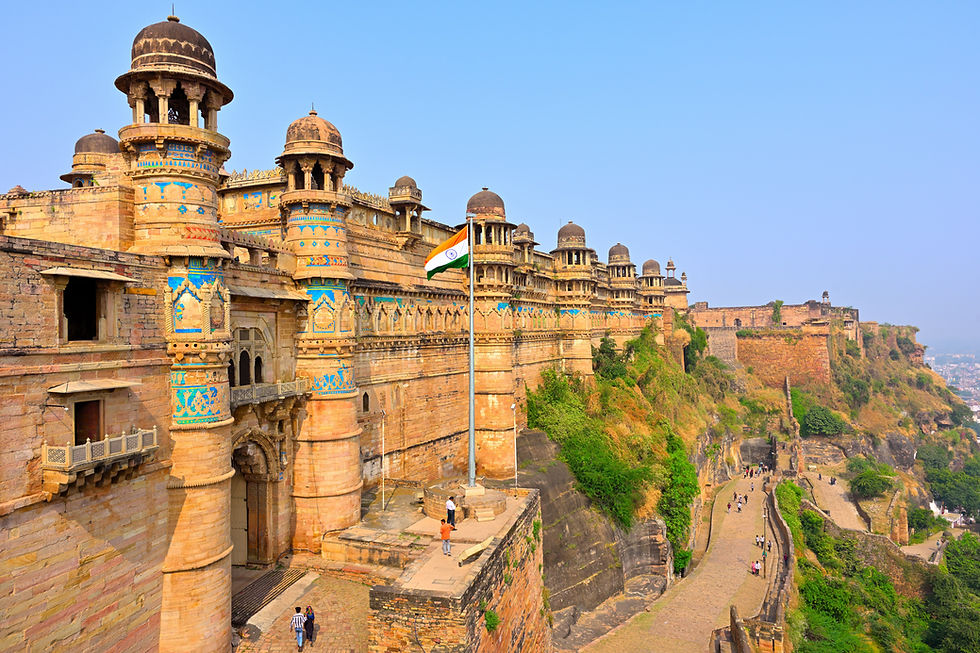
The fort’s golden towers, streaked with cyan, stood guard over the city. I waited for the perfect shot. The moment arrived when the Indian flag caught a gust of hot wind and unfurled above the gate. The Nikon Z8 froze that instant.
After a short rest in the station’s retiring room, my phone buzzed. I had an upgrade from 2AC to First AC. That evening, I found myself in a quiet, spacious cabin, the most comfortable class on Indian Railways.
My co-passenger from Prayagraj said the train would empty after his stop.

Night settled as the train travelled through Bundelkhand. Past midnight, we left Madhya Pradesh and entered Uttar Pradesh. The train traced its path north through the land, drawing me closer to the banks of the Ganges.
The next morning, the train reached Banaras railway station. The platform shone, clean and almost empty. I sat on a red bench and watched the last passengers leave. Varanasi, often so crowded, welcomed me with peace.

This journey was more than travel. Each mile brought me closer to the city’s heart and to the transformation that awaited on the ghats of the Ganges.
Home Away From Home: A Cosy Loft with a Sprawling Terrace
Varanasi’s lodging scene has evolved. Hotels and guesthouses near the ghats once dominated. By 2024, Airbnbs became the choice for urban travellers. These spaces offered modern comforts, clean design, and reliable amenities.

In festive times, a peaceful stay can make all the difference. I preferred Airbnb for its personal touch and quiet. In Varanasi, the location needed to keep the ghats within easy reach. It also had to offer shelter from crowds and the city’s restless noise.
The Airbnb listing fulfilled my wish. I found a one-bedroom loft with a generous bathroom. A narrow staircase climbed to the entrance. Outside the door, a small pantry area held supplies for morning tea and snacks.
Inside, the main room felt airy and inviting. White walls and soft lighting gave the space a gentle glow. The king-sized bed and plush mattress promised restful nights. A smart TV and strong Wi-Fi brought comfort and connection. Even the ceiling fan, remote-controlled, showed thoughtful design.

Next to the bedroom door, a second door opened onto the terrace. Lush greenery framed a pair of rustic lounge chairs.
Motion-sensor rice lights traced the terrace edge. Each evening, they cast a warm yellow glow. Mornings began with tea in the open air, surrounded by quiet and green. This space invited quiet thought before the city’s spiritual tide.

My First Evening Aarti at Dashashwamedh Ghat
Hindus revere the Ganga as the most sacred river. They believe her waters, like a mother’s love, purify and forgive. In India, a ghat means a flight of stairs leading to the riverbank.
Varanasi stretches 6.4 KM along the Ganga crowned by its ghats. It is home to 84 ghats where faith and life play out in countless ways.

Among these, Dashashwamedh Ghat stands out. Its evening aarti draws people from every corner of the world. Devotees seek blessings, travellers chase spectacle, and photographers frame memories.
The aarti, a divine offering, fills the air with chants, the scent of incense, and the ringing of brass bells. Multi-tiered lamps and flowers sway in unison with their glow reflecting on the river.

Arriving two hours early, I found the ghat teeming with life. People pressed forward, voices rising in anticipation of the ceremony.
Ferry operators vied for attention, each promising the best aarti view from the water. The organising committee managed the crowd with safety announcements.

A volunteer climbed the wooden platform with a large bag. Marigold and rose petals spilled out, blanketing it in yellow and pink.
On a saffron-draped stool sat two conches, one small, one large. At the centre, a brass plate of rose petals and an earthen lamp glowed. A kamandal filled with Ganga water stood with its mouth sealed by rose petals.
A tall brass lamp crowned with serpent heads anchored the scene. The setup radiated divine assurance and eased my crowd anxiety.

The priests soon occupied the podiums. Each lifted a massive, multi-tiered brass lamp weighing 4-5 kilograms. Countless tiny flames flickered across its surface. As the ceremony began, the air filled with anticipation.

Despite the heat and weight, they waved the lamps in perfect synchrony. Another pair of hands rang twin bells beside each podium. The synchronised lamps and rhythmic bells created a powerful spiritual harmony.

The next round of aarti introduced hollow serpent-head lamps. Their flames blazed, fierce and bright. The bells and lamps moved in harmony.

As the priests threw the rose petals from the brass plate into the air the aarti neared its end. The crowd stirred and readied to surge. I packed my cameras, slung my bag in front, and slipped away before the rush.

Outside the ghat, locals and evening wanderers filled the lanes. I walked a mile at a brisk pace, reaching a crossroads. One road led to my Airbnb; the other teemed with people near a famous chat shop.
I paused, then joined the crowd for a plate of chaat to end the evening on a tangy note.

Romancing the Ghats: Varanasi Ganga River Cruise
Picture this: an oarsman rowing a wooden boat across the Ganges at predawn. Millions of glistening dots shimmered in the first morning light as the river caught the sun’s glow.
The boat moved forward. Beneath the soothing, melodic voice of the rower, the ripples stilled. Hundreds of birds, all white, arrived at the edge of the boat and then vanished into the horizon.

Once, this was Banaras at sunrise, a time when the ghats exuded unhurried calm. Few manual rowboats now ply the river, most churn forward on the thrust of diesel motors.
These larger, roofed boats packed in more tourists, amplified engine noise and chatter. Leaking fuel and flower offerings mingled in the current, compounding the pollution. The ghats echoed with the relentless hum of motors and the exuberance of crowds.

This surge in river traffic mirrored the houseboat jams of Kerala’s backwaters. Capturing the old-world charm in photographs remained elusive amid the chaos. So, what was the solution?
Amid the clamour, the Alaknanda Cruiseline emerged as a thoughtful alternative. It offered travellers comfort and tranquillity. The multi-floored vessels made a 90-minute ghat round trip.
Between Ravidas Ghat and Raj Ghat, the cruise offers panoramic views. The journey is quieter and minimises environmental impact.

I decided to try Alaknanda Cruiseline services to escape from the crowded, noisy motorboats.
Dawn on the Ganges: The Alaknanda Morning Cruise
My first choice was the most modern vessel in the fleet, named after its parent company, the Alaknanda.
It had two decks. The air-conditioned lower deck, lined with prow windows, provided river views. The roofed upper deck, with wide openings, offered the best vantage point.

The voyage started on time and was smooth, with no noise or vibration rattling the cabin. The staff served complimentary coffee, cookies, and bottled water. The cruise also offered paid ready-to-eat snacks.
Ten minutes in, an announcement invited everyone to the upper deck. The crowd, myself included, moved up broad steps. The morning air refreshed, a marked improvement over the mechanical air-conditioning below.
Downstairs, numbered seats could be pre-selected online. My soft leather window seat offered comfort. Up top, order vanished: unreserved plastic chairs now lined the deck.

With two cameras around my neck, I lost the scramble for seats, but squeezed in next to a newlywed couple. Seeing my predicament, they made space for me.
One of my early shots captured the contrasts of modern-day Varanasi. Vibrant buildings and boats lined quiet ghats. Maroons, yellows, and blues from boats and buildings blended old and new.
Motorised and manual boats floated together in front of facades that spanned generations.

My next best capture was the western entrance to the famed Shri Vishwanath Temple. The temple's strenuous redevelopment took four long years.
Broad areas, like the wide ghat steps, were a hallmark of its design, making it suitable for heavy crowds.

My favourite from hundreds of photos was this charming frame at Bhonsale Ghat. Blue boats dotted the near-empty ghat, giving the scene a cinematic quality. Gentle swells moved across the greenish water, completing the picture.

As we continued, the iconic Malviya Bridge appeared. This double-decker structure carried both road and rail traffic for over 137 years.
In 2024, Indian Railways announced plans to transform the bridge. This will see a six-lane highway on top and four railway lines below. Once finished, the bridge will rank among the largest in the world for handling traffic.
As I photographed the bridge, an old ICF train crossed, bringing history to life.

We slowed at Namo Ghat. The old Khidkiya Ghat underwent a symbolic makeover with giant folded-hands sculptures. The gesture, a namaskar, reflects worship of the Sun and River Ganga.
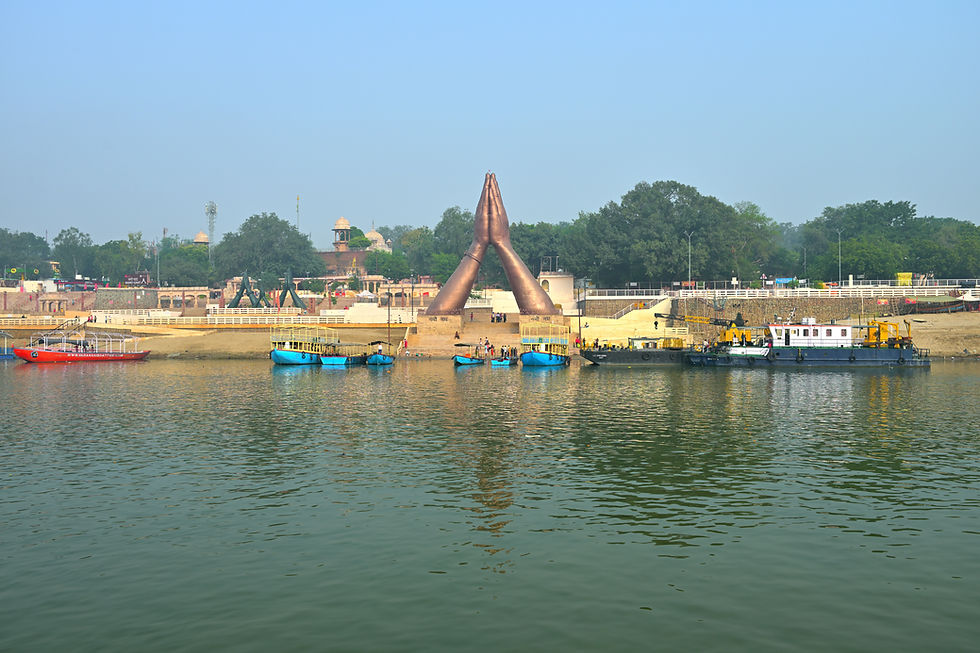
The vessel took a U-turn at the end of Namo Ghat. Anticipating the turn, I moved to the other side for a better view. Comfortable with my camera bag, my shots improved.
Morning mist clung as I framed Namo Ghat and Malviya Bridge in dense fog for my first shot after the turn.

A calm moment arrived near Shitala Ghat. The broad, beige steps of the languid ghat offered a stark contrast to the city’s usual chaos. The steps narrowed as they rose toward the cramped lanes above.
Cream-coloured buildings loomed above the ghat, engulfing the steps. The dense clusters of buildings blocked the view, cutting off any sense of a world beyond.

I took many images with symmetrical structures along the ghats. The symmetry gave way to something extraordinary at the edge of Manikarnika Ghat.
Notice the tilted temple at the extreme right in the photo below. This is the Ratneshwar Temple renowned for its 9° tilt. This angle is more than double the slant of the Leaning Tower of Pisa.

As the boat neared Dashashwamedh Ghat, the silence of the river’s quieter stretches gave way. The empty boats drifted on, but ahead, the ghat already stirring. It was a subtle shift, hinting at the energy that would erupt hours later.

As we drifted further, a dazzling expanse of whites captured my attention. On the sloping bank of Babua Pandey Ghat, the washerman’s ghat, a large array of white fabrics lay in neat groups. Their brightness caught my eye as the sole vivid detail in the muted scene.

On the journey's last leg, another set of whites caught my eye at Jain Ghat. Three large rectangular boxes stood out along the ghat’s broad, sloping bank. Two were empty, while the third bore four Hindi words in blue.
A man approached this inscribed box, which read जियो और जीने दो. The words live and let live felt meaningful beside the calm Ganges.

Prelude to Dev Diwali: Alaknanda Evening Cruise and Illuminated Ghats
I had two leisure evenings ahead of the eventful night of Dev Diwali. Watching the Varanasi ghats prepare for the festival in daylight was enchanting. This inspired me to witness their transformation at night before the big event.
To soak in the illumination, I chose an evening cruise with Alaknanda Cruiseline. This time, I opted for the fleet’s ferry-style boat over the previous Alaknanda vessel. It was large, featuring a huge open deck and multi-tiered upper floors.
The fleet comprised identical ferry boats named Sam Manekshaw and Swami Vivekananda.

I boarded the Sam Manekshaw as pale blue dusk faded to pitch black. The vessel picked up speed. Strings of golden lights brightened the undulating buildings along the shore. Their reflections shimmered in thick layers on the waves of the Ganga.

Ahead, Bhonsale Ghat glowed amber under subtle lights. The open second deck provided an excellent vantage point. With fewer boats in the way, the ghat looked pristine.

As we continued, ornamental lights adorned hundreds of buildings, awing everyone on board. Remember the Jain Ghat with its three large white boxes? The third box now displayed another Hindi message, अहिंसा परमो धर्म.
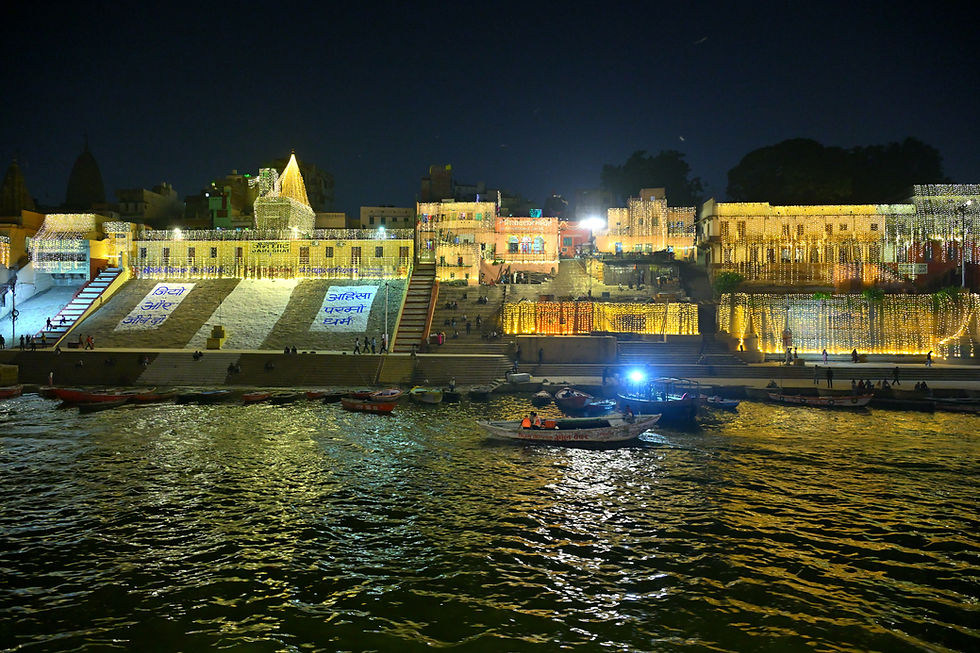
The message, non-violence is the supreme virtue, spoke of global peace, a hope often ignored. Glowing yellow and orange buildings blended with the small boat’s headlight near the ghat.
Together, they demonstrated how unity outshines vulnerability. It was a reminder that every light, when joined, makes the night less daunting.
Nearing the end of the journey, Assi Ghat gleamed with lustrous lights and a vibrant crowd. Evenings often transform this ghat into an open-air theatre for cultural activities.

As I left the vessel, I made a mental note of the brightest spots for capturing the magic of Dev Diwali night.
Aarti from the Water: Dashaswamedh Ghat by Alaknanda Cruiseline
For my second evening cruise, I chose to witness the Ganga Aarti from Dashaswamedh Ghat. This time, I boarded Alaknanda Cruiseline's Swami Vivekananda vessel.
The vessel gained speed on this breezy evening, then slowed near a dark ghat. Bright, multi-coloured laser beams shot up from the ghat’s edge, slicing through the darkness.
The fort at Chet Singh Ghat dazzled in deep red lights, while blue laser streaks danced across its façade.

Nearing Manikarnika Ghat, we observed the other Alaknanda Cruiseline vessel, Sam Manekshaw, hosting a private party.
Yellow floodlights from our vessel blended with the decorative magentas of the other, turning the black waters into a riot of colours.

The defining moment arrived as we neared Dashaswamedh Ghat. The vessel aligned parallel to the ghat, offering a clear view of the aarti.
Many boats of all sizes queued ahead. Between the lit buildings and the sea of boats, the aarti podium appeared tiny.

I shot the picture above at 41mm, close to the human eye’s field of view. I saw the zoomed view with my telephoto lens, but chose to present the real view most tourists see without special camera gear.
Chants and bells carried from the aarti podium. Surrounded by diyas and the Ganga, the moment shimmered with spirituality.
Dev Diwali Unfolds: Lights, Legends, and Living Spirituality
On normal days, traffic halts at Godowalia Chauraha. From there, it’s a 600-metres walk to Dashashwamedh Ghat. On Dev Diwali eve in 2024, the crowd swelled. Traffic stopped even earlier, at Girija Ghar Crossing.
The short walk to Godowalia felt like wading through a river of people. Police barricades blocked entry to Dashashwamedh Ghat.

I took a detour along a wider road, where vehicle blockades allowed easier movement. After walking about 1.5 KM, I found a narrow lane that locals said would lead to the ghat.
The lane looked calm but soon narrowed, filling with people. Each turn tightened the labyrinth, the crowd pressing in from all sides.
A shout from the crowd warned of steep, narrow steps ahead. I paused on a parapet, letting the crowd pass before descending. Shoulder to shoulder, we moved down, each step tense with the fear of a stampede.
Soon, the stairs widened. I emerged at Pandey Ghat. Here, glittering lights washed the journey’s stress away.

In a dark corner, a faint glow revealed people sitting in shadow. As I stepped closer, the glow intensified, revealing diyas arranged in a swastika.
Their radiance dispelled my fears, filling me with calm and hope. The swastika, a Hindu symbol of good fortune, felt alive in that moment.
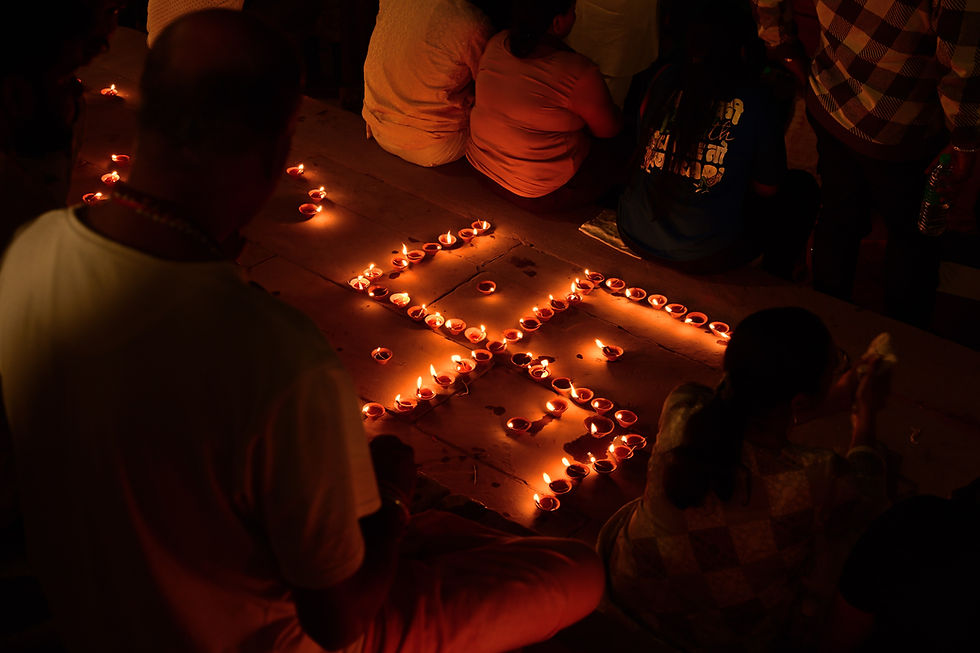
A little ahead, the crowd and diyas formed an L-shaped pattern. The scene harmonised as lights, people, and boats blended into a perfect whole. The ghat’s energy transformed from overwhelming to uplifting.

A loud bang startled me. Firecrackers lit the sky. Tall yellow buildings sparkled with tiny lights. Fiery streaks reflected on the black water, animating the night.

A dense crowd clustered below the railing pulled me in. Three intricate white rangolis glowed at the centre. A divine Ganesh stood between an eight-sided and a sixteen-sided design. From a distance, countless diyas appeared on their edges.
The crowd pressed in, blocking any chance of a people-free shot. I decided to include the crowd for authenticity. A man posed beside Ganesh. Children masked part of the larger shape, sparking life and spontaneity in the scene.

Further on, giant earthen lamps radiated intense heat. I risked a closer shot, even though the heat threatened my body and the camera. The frame presented below would have compelled anyone to do so.

A marigold border wrapped around hundreds of black diyas shaped into a giant Shiv Ling. Though unlit, the arrangement exuded divinity.
Children lit fireworks, their red and white flashes backlighting the design. This was a perfect embodiment of Dev Diwali’s spirit and Shiva’s triumph.

Insider Tips for Experiencing Dev Diwali in Varanasi
This section answers common questions offering practical advice for Dev Diwali in Varanasi. Click the arrow before each question to view its answer.
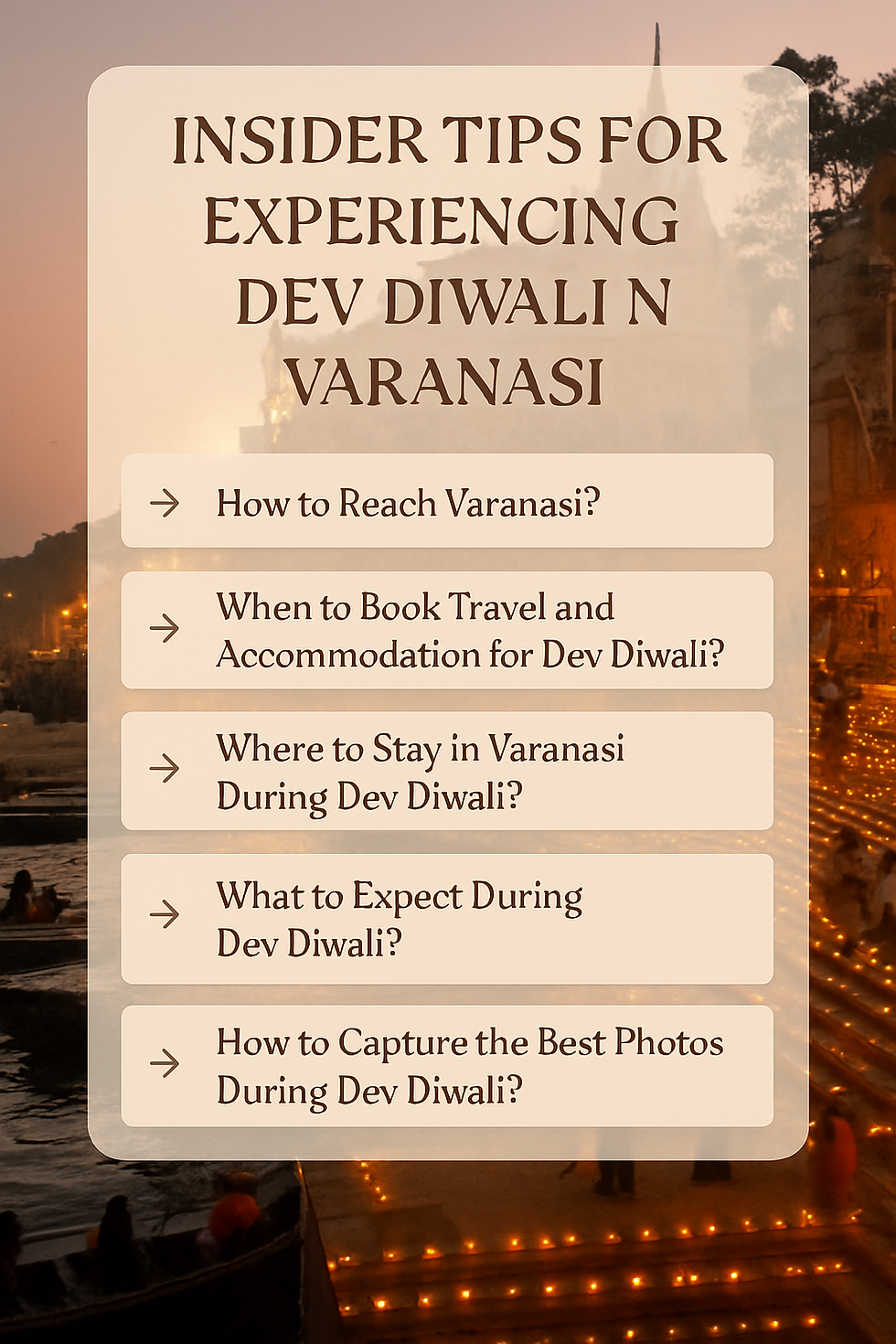
How to Reach Varanasi?
Varanasi links to major Indian cities by air, rail, and road. The city has an international airport (IATA Code: VNS) and a busy railway station (IRCTC Station Code: BSB).
For flights, book three to four months ahead, especially on weekdays, to find better deals.
Indian Railways opens bookings 120 days in advance. Book your train ticket at 8 AM IST on the first day of the booking window for the best chance at a confirmed seat.
When to Book Travel and Accommodation for Dev Diwali?
Secure your travel and accommodation early. Dev Diwali draws huge crowds, and availability drops as the festival approaches.
Where to Stay in Varanasi During Dev Diwali?
Your choice depends on your preferences. Staying near the ghats puts you at the heart of the action but also exposes you to noise and crowds. For a quieter experience, choose a nearby area off the ghats.
I stayed at an Airbnb in Jagatganj, a short walk from Lahurabir Chauraha. From Lahurabir Chauraha, you can take hand-pulled rickshaws or shared autos. These make the 1.8-kilometre journey to Dashashwamedh Ghat easy.
Use trusted booking platforms like MakeMyTrip, GoIbibo, or Airbnb.
What to Expect During Dev Diwali?
Prepare for vibrant ghats, countless diyas, and massive crowds. The festive atmosphere buzzes with energy. Stay alert and watch your belongings, as large crowds sometimes attract opportunistic behaviour.
If you’re sensitive to smoke or noise, consider viewing the celebrations from a boat or from less crowded ghats farther from Dashashwamedh.
How to Capture the Best Photos During Dev Diwali?
Decide whether you want to experience the ghats on foot or from the water.
Over a million visitors pack the ghats. Consider booking a boat ride for a unique view of the illuminated ghats from the river.
For high-quality photos, use a real camera. Phone cameras often struggle in low light.
If you don't own a camera, consider renting one.
Pair the camera body with a 24–70mm f/2.8 lens for best results.
If you use two bodies, add a 20mm or 50mm f/1.8 prime and a 24–105mm or 24–120mm f/4 zoom.
I used Nikon mirrorless bodies Z8 and Z7 with 24-120mm f/4, 20mm f/1.8, and 100-400mm f/4.5-5.6 Nikkor Z lenses.
What are Safety Tips and Local Customs for Dev Diwali?
Carry only essentials in a secure sling bag or wear your backpack in front.
Arrive at the ghats by 3:00 or 3:30 PM for a good spot. Move with the crowd, avoid rushing into narrow lanes, and stay patient.
Respect local rituals and dress modestly.
Always ask permission before photographing people or holy offerings.
What is the Date for Varanasi Dev Diwali in 2026?
In 2026, Varanasi will celebrate Dev Diwali on November 24. The lunar calendar determines the date. Re-confirm the festival date before booking.
My Dev Diwali Reflection: Varanasi's Enduring Glow
Varanasi’s Dev Diwali was a long-awaited, offbeat, and evocative experience for me. Armed with professional camera gear, my eagerness to witness the event grew stronger.
My journey mirrored the diya-lit rangoli I captured at one of Varanasi’s ghats on Dev Diwali night. As seen below, the rangoli sparkled despite the rough, symmetrical spread of colors.
A few diyas on the edges remained unlit, but the surrounding colours gave them their own radiance.

The walk, the crowd, and the anxious moments will remain etched in my heart. The photographs you saw in the post reflect this experience and my immersion in its glow and spirit.
I hope my trip inspires you to visit Varanasi for your own Dev Diwali experience.
Whether you’ve already taken the journey or plan to in the future, do write back in the comments with your thoughts. If you enjoyed reading, do like the post and share it.
The festival’s light lingers not on the ghats, but in the hearts of all who witness it.


Comments